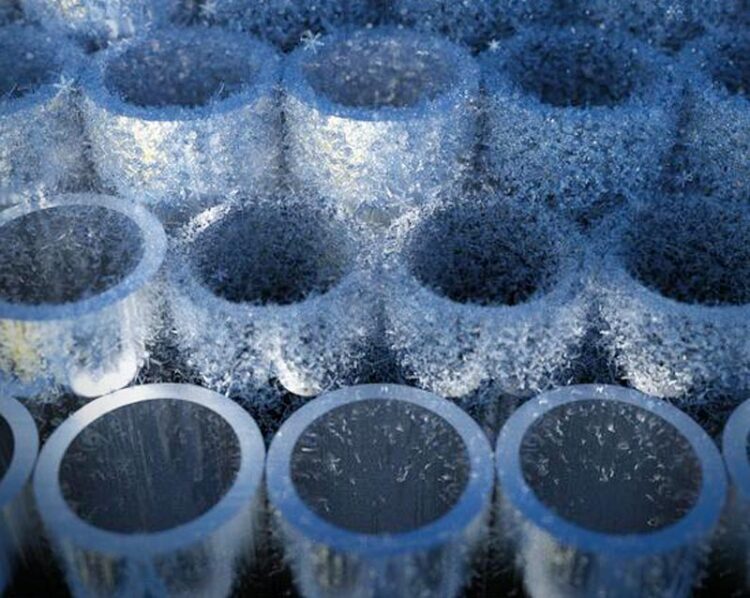Elastocaloric cooling system opens door to climate-friendly AC

Metallic solid-state refrigerant tubes used for elastocaloric cooling, an environmentally friendly refrigeration technology.
Credit: Jiaqi Dai/Maryland Engineering
Air conditioning, refrigeration, and other cooling technologies account for more than 20 percent of today’s global energy consumption, while the refrigerants they use have a global warming potential thousands of times greater than carbon dioxide. In a recent study in the journal Science, a team led by Maryland Engineering Professors Ichiro Takeuchi, Reinhard Radermacher, and Yunho Hwang introduced a high-performance elastocaloric cooling system that could represent the next generation of cooling devices.
Takeuchi calls it “a completely different, completely green, environmentally friendly cooling technology, which bypasses chemical refrigerants to essentially rely on pushing and pulling pieces of metal to create cooling.” Caloric materials—including magnetocaloric, electrocaloric, and elastocaloric materials—can undergo phase transition and release, and absorb heat upon application of various fields and mechanical forces. The key feature is the compression and release of fatigue-resistant nickel-titanium (NiTi) tubes configured in a versatile, multimode heat exchange architecture.
“More than a decade ago, we were just playing with a NiTi wire,” Takeuchi said. “By stretching it, you could get a substantial cooling effect one could feel by hand. That was when we started thinking about applying the concept to a cooling device.” The lab’s subsequent work has been funded by the U.S. Department of Energy for more than a decade.
The team says it’s possible to improve the performance of its system enough to make the technology commercially viable within several years. A current prototype can produce 200 watts of cooling capacity, enough to power a compact wine fridge, with plans to expand to window units, whole-house cooling systems, and commercial HVACs eventually.
The A. James Clark School of Engineering at the University of Maryland serves as the catalyst for high-quality research, innovation, and learning, delivering on a promise that all graduates will leave ready to impact the Grand Challenges of the 21st century. The Clark School is dedicated to leading and transforming the engineering discipline and profession, to accelerating entrepreneurship, and to transforming research and learning activities into new innovations that benefit millions.
Journal: Science
DOI: 10.1126/science.adg7043
Article Title:High-performance multimode elastocaloric cooling system
Article Publication Date: 18-May-2023
All latest news from the category: Machine Engineering
Machine engineering is one of Germany’s key industries. The importance of this segment has led to the creation of new university degree programs in fields such as production and logistics, process engineering, vehicle/automotive engineering, production engineering and aerospace engineering among others.
innovations-report offers informative reports and articles covering technologies such as automation, motion, power train, energy, conveyor, plastics, lightweight construction, logistics/warehousing, measurement systems, machine tools and control engineering.
Newest articles

Innovative 3D printed scaffolds offer new hope for bone healing
Researchers at the Institute for Bioengineering of Catalonia have developed novel 3D printed PLA-CaP scaffolds that promote blood vessel formation, ensuring better healing and regeneration of bone tissue. Bone is…

The surprising role of gut infection in Alzheimer’s disease
ASU- and Banner Alzheimer’s Institute-led study implicates link between a common virus and the disease, which travels from the gut to the brain and may be a target for antiviral…

Molecular gardening: New enzymes discovered for protein modification pruning
How deubiquitinases USP53 and USP54 cleave long polyubiquitin chains and how the former is linked to liver disease in children. Deubiquitinases (DUBs) are enzymes used by cells to trim protein…



